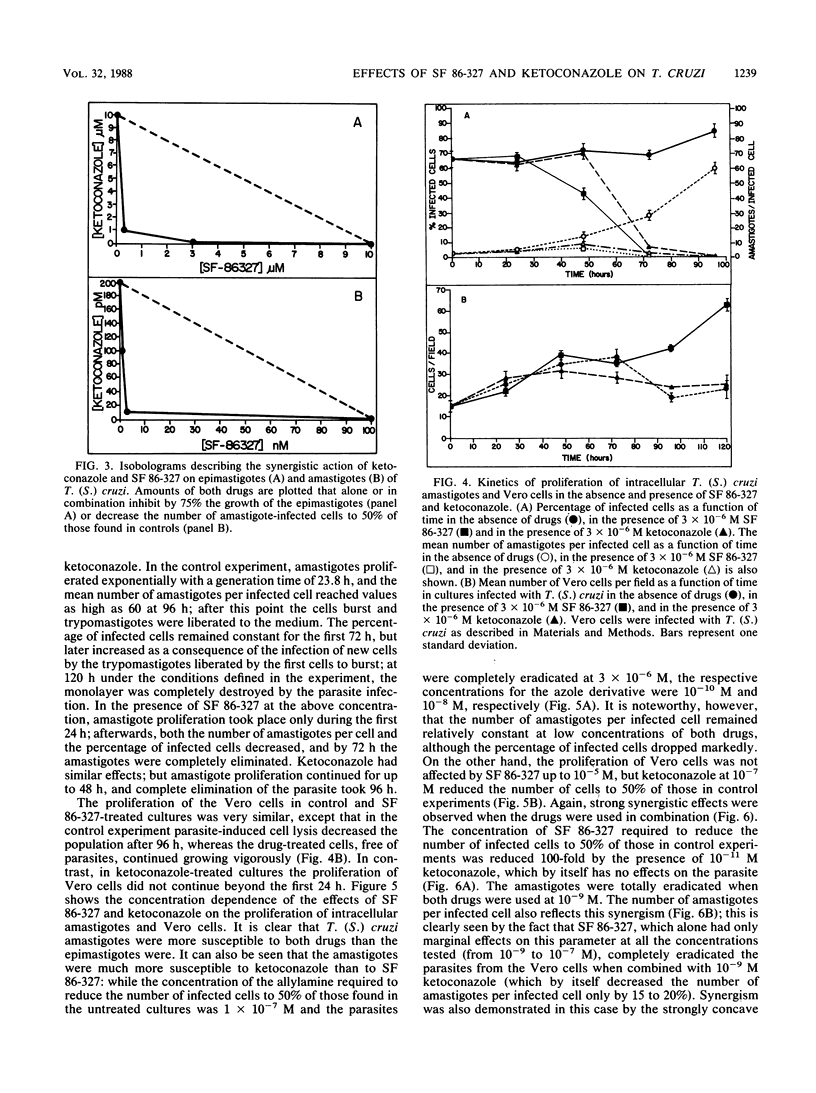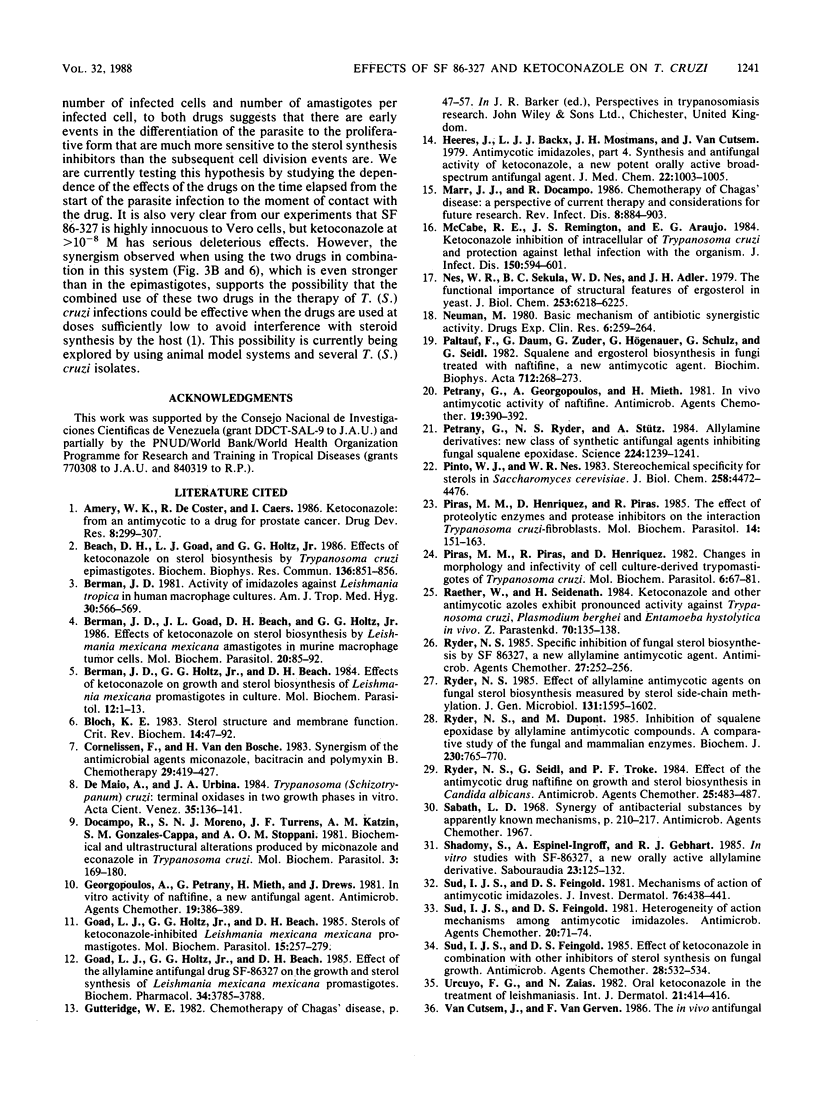Abstract
We have investigated the growth-inhibitory effects of two ergosterol biosynthesis inhibitors, the dioxolane imidazole ketoconazole and the allylamine SF 86-327, alone and in combination, on the proliferative stages of Trypanosoma (Schizotrypanum) cruzi, the causative agent of Chagas' disease. Proliferation of epimastigotes in liver infusion-tryptose medium at 28 degrees C was immediately arrested by any of these drugs at greater than or equal to 3 x 10(-5) M; cell lysis occurred 24 h later. Below that concentration, SF 86-327 at concentrations down to 1 x 10(-6) M stopped growth after 48 h. In contrast, ketoconazole slowed cell growth only moderately, but proliferation finally stopped and cell lysis occurred after 120 h at 3 x 10(-6) M. Synergistic effects could be observed when the two drugs were used in combination: the concentration of SF 86-327 required to reduce the cell growth to 25% of controls in 144 h was reduced 33-fold in the presence of 1 x 10(-6) M ketoconazole, which by itself reduced growth only by 30%. Amastigotes, proliferating in Vero cells at 37 degrees C, were much more susceptible to both drugs, but ketoconazole was definitely a more potent antiparasitic agent than the allylamine in this system: whereas the concentration of SF 86-327 required to reduce the number of infected cells to 50% of controls was 1 x 10(-7) M and that required to completely eradicate the parasite was 3 x 10(-6) M, for ketoconazole these concentrations were 1 x 10(-10) M and 1 x 10(-8) M, respectively. Again, strong synergistic effects were observed when the drugs were used in combination: the concentration of SF 86-327 required to reduce the number of infected cells to 50% of controls was 100-fold lower in the presence of 10(-11) M ketoconazole, which by itself had no effects on amastigote proliferation. The parasite was completely eradicated when the drugs were used in combination at concentrations as low as 10(-9) M. Synergy of the antiproliferative effects of the drugs on both froms of the parasite was further demonstrated by concave isobolograms. On the other hand, SF 86-327 at 10(-5) M had no effects on the proliferation of Vero cells, whereas ketoconazole at 10(-7) M reduced the proliferation of these cells by 50%.
Full text
PDF





Selected References
These references are in PubMed. This may not be the complete list of references from this article.
- Beach D. H., Goad L. J., Holz G. G., Jr Effects of ketoconazole on sterol biosynthesis by Trypanosoma cruzi epimastigotes. Biochem Biophys Res Commun. 1986 May 14;136(3):851–856. doi: 10.1016/0006-291x(86)90410-9. [DOI] [PubMed] [Google Scholar]
- Berman J. D. Activity of imidazoles against Leishmania tropica in human macrophage cultures. Am J Trop Med Hyg. 1981 May;30(3):566–569. doi: 10.4269/ajtmh.1981.30.566. [DOI] [PubMed] [Google Scholar]
- Berman J. D., Goad L. J., Beach D. H., Holz G. G., Jr Effects of ketoconazole on sterol biosynthesis by Leishmania mexicana mexicana amastigotes in murine macrophage tumor cells. Mol Biochem Parasitol. 1986 Jul;20(1):85–92. doi: 10.1016/0166-6851(86)90145-3. [DOI] [PubMed] [Google Scholar]
- Berman J. D., Holz G. G., Jr, Beach D. H. Effects of ketoconazole on growth and sterol biosynthesis of Leishmania mexicana promastigotes in culture. Mol Biochem Parasitol. 1984 May;12(1):1–13. doi: 10.1016/0166-6851(84)90039-2. [DOI] [PubMed] [Google Scholar]
- Bloch K. E. Sterol structure and membrane function. CRC Crit Rev Biochem. 1983;14(1):47–92. doi: 10.3109/10409238309102790. [DOI] [PubMed] [Google Scholar]
- Cornelissen F., Van den Bossche H. Synergism of the antimicrobial agents miconazole, bacitracin and polymyxin B. Chemotherapy. 1983;29(6):419–427. doi: 10.1159/000238230. [DOI] [PubMed] [Google Scholar]
- Docampo R., Moreno S. N., Turrens J. F., Katzin A. M., Gonzalez-Cappa S. M., Stoppani A. O. Biochemical and ultrastructural alterations produced by miconazole and econazole in Trypanosoma cruzi. Mol Biochem Parasitol. 1981 Jul;3(3):169–180. doi: 10.1016/0166-6851(81)90047-5. [DOI] [PubMed] [Google Scholar]
- Georgopoulos A., Petranyi G., Mieth H., Drews J. In vitro activity of naftifine, a new antifungal agent. Antimicrob Agents Chemother. 1981 Mar;19(3):386–389. doi: 10.1128/aac.19.3.386. [DOI] [PMC free article] [PubMed] [Google Scholar]
- Goad L. J., Holz G. G., Jr, Beach D. H. Effect of the allylamine antifungal drug SF 86-327 on the growth and sterol synthesis of Leishmania mexicana mexicana promastigotes. Biochem Pharmacol. 1985 Oct 15;34(20):3785–3788. doi: 10.1016/0006-2952(85)90250-3. [DOI] [PubMed] [Google Scholar]
- Goad L. J., Holz G. G., Jr, Beach D. H. Sterols of ketoconazole-inhibited Leishmania mexicana mexicana promastigotes. Mol Biochem Parasitol. 1985 Jun;15(3):257–279. doi: 10.1016/0166-6851(85)90089-1. [DOI] [PubMed] [Google Scholar]
- Heeres J., Backx L. J., Mostmans J. H., Van Cutsem J. Antimycotic imidazoles. part 4. Synthesis and antifungal activity of ketoconazole, a new potent orally active broad-spectrum antifungal agent. J Med Chem. 1979 Aug;22(8):1003–1005. doi: 10.1021/jm00194a023. [DOI] [PubMed] [Google Scholar]
- Marr J. J., Docampo R. Chemotherapy for Chagas' disease: a perspective of current therapy and considerations for future research. Rev Infect Dis. 1986 Nov-Dec;8(6):884–903. doi: 10.1093/clinids/8.6.884. [DOI] [PubMed] [Google Scholar]
- McCabe R. E., Remington J. S., Araujo F. G. Ketoconazole inhibition of intracellular multiplication of Trypanosoma cruzi and protection of mice against lethal infection with the organism. J Infect Dis. 1984 Oct;150(4):594–601. doi: 10.1093/infdis/150.4.594. [DOI] [PubMed] [Google Scholar]
- Nes W. R., Sekula B. C., Nes W. D., Adler J. H. The functional importance of structural features of ergosterol in yeast. J Biol Chem. 1978 Sep 10;253(17):6218–6225. [PubMed] [Google Scholar]
- Petranyi G., Georgopoulos A., Mieth H. In vivo antimycotic activity of naftifine. Antimicrob Agents Chemother. 1981 Mar;19(3):390–392. doi: 10.1128/aac.19.3.390. [DOI] [PMC free article] [PubMed] [Google Scholar]
- Petranyi G., Ryder N. S., Stütz A. Allylamine derivatives: new class of synthetic antifungal agents inhibiting fungal squalene epoxidase. Science. 1984 Jun 15;224(4654):1239–1241. doi: 10.1126/science.6547247. [DOI] [PubMed] [Google Scholar]
- Pinto W. J., Nes W. R. Stereochemical specificity for sterols in Saccharomyces cerevisiae. J Biol Chem. 1983 Apr 10;258(7):4472–4476. [PubMed] [Google Scholar]
- Piras M. M., Henriquez D., Piras R. The effect of proteolytic enzymes and protease inhibitors on the interaction Trypanosoma cruzi-fibroblasts. Mol Biochem Parasitol. 1985 Feb;14(2):151–163. doi: 10.1016/0166-6851(85)90034-9. [DOI] [PubMed] [Google Scholar]
- Piras M. M., Piras R., Henriquez D., Negri S. Changes in morphology and infectivity of cell culture-derived trypomastigotes of Trypanosoma cruzi. Mol Biochem Parasitol. 1982 Aug;6(2):67–81. doi: 10.1016/0166-6851(82)90066-4. [DOI] [PubMed] [Google Scholar]
- Raether W., Seidenath H. Ketoconazole and other potent antimycotic azoles exhibit pronounced activity against Trypanosoma cruzi, Plasmodium berghei and Entamoeba histolytica in vivo. Z Parasitenkd. 1984;70(1):135–138. doi: 10.1007/BF00929583. [DOI] [PubMed] [Google Scholar]
- Ryder N. S., Dupont M. C. Inhibition of squalene epoxidase by allylamine antimycotic compounds. A comparative study of the fungal and mammalian enzymes. Biochem J. 1985 Sep 15;230(3):765–770. doi: 10.1042/bj2300765. [DOI] [PMC free article] [PubMed] [Google Scholar]
- Ryder N. S. Effect of allylamine antimycotic agents on fungal sterol biosynthesis measured by sterol side-chain methylation. J Gen Microbiol. 1985 Jul;131(7):1595–1602. doi: 10.1099/00221287-131-7-1595. [DOI] [PubMed] [Google Scholar]
- Ryder N. S., Seidl G., Troke P. F. Effect of the antimycotic drug naftifine on growth of and sterol biosynthesis in Candida albicans. Antimicrob Agents Chemother. 1984 Apr;25(4):483–487. doi: 10.1128/aac.25.4.483. [DOI] [PMC free article] [PubMed] [Google Scholar]
- Ryder N. S. Specific inhibition of fungal sterol biosynthesis by SF 86-327, a new allylamine antimycotic agent. Antimicrob Agents Chemother. 1985 Feb;27(2):252–256. doi: 10.1128/aac.27.2.252. [DOI] [PMC free article] [PubMed] [Google Scholar]
- Shadomy S., Espinel-Ingroff A., Gebhart R. J. In-vitro studies with SF 86-327, a new orally active allylamine derivative. Sabouraudia. 1985 Apr;23(2):125–132. doi: 10.1080/00362178585380201. [DOI] [PubMed] [Google Scholar]
- Sud I. J., Feingold D. S. Effect of ketoconazole in combination with other inhibitors of sterol synthesis on fungal growth. Antimicrob Agents Chemother. 1985 Oct;28(4):532–534. doi: 10.1128/aac.28.4.532. [DOI] [PMC free article] [PubMed] [Google Scholar]
- Sud I. J., Feingold D. S. Heterogeneity of action of mechanisms among antimycotic imidazoles. Antimicrob Agents Chemother. 1981 Jul;20(1):71–74. doi: 10.1128/aac.20.1.71. [DOI] [PMC free article] [PubMed] [Google Scholar]
- Sud I. J., Feingold D. S. Mechanisms of action of the antimycotic imidazoles. J Invest Dermatol. 1981 Jun;76(6):438–441. doi: 10.1111/1523-1747.ep12521036. [DOI] [PubMed] [Google Scholar]
- Urcuyo F. G., Zaias N. Oral ketoconazole in the treatment of leishmaniasis. Int J Dermatol. 1982 Sep;21(7):414–416. doi: 10.1111/j.1365-4362.1982.tb03163.x. [DOI] [PubMed] [Google Scholar]
- Van den Bossche H., Ruysschaert J. M., Defrise-Quertain F., Willemsens G., Cornelissen F., Marichal P., Cools W., Van Cutsem J. The interaction of miconazole and ketoconazole with lipids. Biochem Pharmacol. 1982 Aug 15;31(16):2609–2617. doi: 10.1016/0006-2952(82)90707-9. [DOI] [PubMed] [Google Scholar]
- Van den Bossche H., Willemsens G., Cools W., Cornelissen F., Lauwers W. F., van Cutsem J. M. In vitro and in vivo effects of the antimycotic drug ketoconazole on sterol synthesis. Antimicrob Agents Chemother. 1980 Jun;17(6):922–928. doi: 10.1128/aac.17.6.922. [DOI] [PMC free article] [PubMed] [Google Scholar]
- Weinrauch L., Livshin R., El-On J. Cutaneous leishmaniasis: treatment with ketoconazole. Cutis. 1983 Sep;32(3):288-9, 294. [PubMed] [Google Scholar]
- de Maio A., Urbina J. A. Trypanosoma (Schizotrypanum) cruzi: terminal oxidases in exponential and stationary growth phase emipastigotes cultured in vitro. Acta Cient Venez. 1984;35(2):136–141. [PubMed] [Google Scholar]
- van den Bossche H., Willemsens G., Cools W., Lauwers W. F., Le Jeune L. Biochemical effects of miconazole on fungi. II. Inhibition of ergosterol biosynthesis in Candida albicans. Chem Biol Interact. 1978 Apr;21(1):59–78. doi: 10.1016/0009-2797(78)90068-6. [DOI] [PubMed] [Google Scholar]


